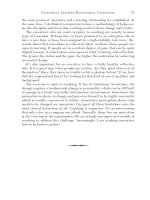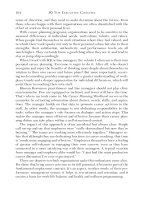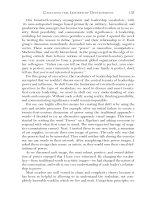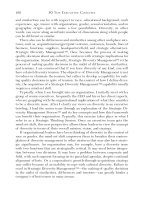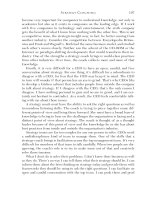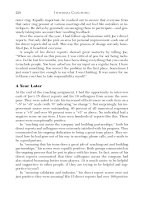The art and practice of leadership coaching phần 1 pdf
Bạn đang xem bản rút gọn của tài liệu. Xem và tải ngay bản đầy đủ của tài liệu tại đây (335.01 KB, 31 trang )
The Art and Practice of
Leadership
Coaching
TLFeBOOK
The Art and Practice of
LEADERSHIP
Coaching
50 Top Executive Coaches Reveal Their Secrets
Edited by Howard Morgan,
Phil Harkins, and Marshall Goldsmith
JOHN WILEY & SONS, INC.
Copyright © 2005 by Linkage, Inc. All rights reserved.
Published by John Wiley & Sons, Inc., Hoboken, New Jersey.
Published simultaneously in Canada.
An earlier version of this book was published in 2003 by Linkage Press under the title
Profiles in Coaching.
No part of this publication may be reproduced, stored in a retrieval system, or transmitted
in any form or by any means, electronic, mechanical, photocopying, recording, scanning, or
otherwise, except as permitted under Section 107 or 108 of the 1976 United States
Copyright Act, without either the prior written permission of the Publisher, or
authorization through payment of the appropriate per-copy fee to the Copyright Clearance
Center, Inc., 222 Rosewood Drive, Danvers, MA 01923, (978) 750-8400, fax (978) 646-
8600, or on the web at www.copyright.com. Requests to the Publisher for permission should
be addressed to the Permissions Department, John Wiley & Sons, Inc., 111 River Street,
Hoboken, NJ 07030, (201) 748-6011, fax (201) 748-6008.
Limit of Liability/Disclaimer of Warranty: While the publisher and author have used their
best efforts in preparing this book, they make no representations or warranties with respect
to the accuracy or completeness of the contents of this book and specifically disclaim any
implied warranties of merchantability or fitness for a particular purpose. No warranty may
be created or extended by sales representatives or written sales materials. The advice and
strategies contained herein may not be suitable for your situation. The publisher is not
engaged in rendering professional services, and you should consult a professional where
appropriate. Neither the publisher nor author shall be liable for any loss of profit or any
other commercial damages, including but not limited to special, incidental, consequential,
or other damages.
For general information on our other products and services please contact our Customer
Care Department within the United States at (800) 762-2974, outside the United States at
(317) 572-3993 or fax (317) 572-4002.
Wiley also publishes its books in a variety of electronic formats. Some content that appears
in print may not be available in electronic books. For more information about Wiley
products, visit our web site at www.wiley.com.
Library of Congress Cataloging-in-Publication Data:
The art and practice of leadership coaching : 50 top executive coaches
reveal their secrets / edited by Howard Morgan, Phil Harkins, Marshall
Goldsmith.
p. cm.
Includes bibliographical references.
ISBN 0-471-70546-2 (cloth)
1. Leadership—Study and teaching. 2. Executives—Training of. 3.
Mentoring in business. 4. Business consultants. I. Title: 50 top
executive coaches reveal their secrets. II. Morgan, Howard J. III. Harkins,
Philip J. IV. Goldsmith, Marshall.
HD57.7.A77 2004
658.4′092—dc22
2004016225
Printed in the United States of America.
10987654321
This book is dedicated to the memory of
P. Graham Hollihan,
a leader who coached to the strengths of many people,
encouraged confidence in their potential, and
put them in the best position to learn, grow, and succeed.
vii
Contents
Acknowledgments xi
About the Editors xiii
Research Sponsor: Linkage, Inc. xvii
Research Partner: Hewitt Associates xix
1 The Coaching Landscape, by Linkage, Inc. 1
P
ART
IW
ORKING WITH
C
OACHES
21
2 Selecting the Right Coach 23
3 Creating a Powerful Coach-Coachee Partnership 41
P
ART
II 50 T
OP
E
XECUTIVE
C
OACHES
53
4 Coaching Leaders/Behavioral Coaching 55
Marshall Goldsmith, 56
Jim Kouzes, 61
Frances Hesselbein, 67
Jay Conger, 68
Dave Ulrich, 74
Barry Posner, 76
Howard Morgan, 78
Ken Siegel, 80
Bobbie Little, 83
Kim Barnes, 85
5 Career/Life Coaching 87
Richard J. Leider, 88
William Bridges, 93
Beverly Kaye, 97
David Allen, 100
Barbara Moses, 103
Brian Tracy, 106
Shirley Anderson, 110
Joel Garfinkle, 112
viii C
ONTENTS
Richard Strozzi-Heckler, 115
Marian Baker, 117
6 Coaching for Leadership Development 121
Noel M. Tichy, 122
Robert M. Fulmer, 125
Ken Blanchard, 127
Paul Hersey, 130
Nancy J. Adler, 131
Albert A. Vicere, 137
John Alexander, 140
Jim Bolt, 143
David Giber, 146
Jim Moore, 149
7 Coaching for Organizational Change 153
Phil Harkins, 154
W. War ner Burke, 159
Sally Helgesen, 161
R. Roosevelt Thomas Jr., 165
Gifford Pinchot, 168
David Dotlich, 173
Stratford Sherman, 176
Gary Ranker, 179
Leigh Fountain, 183
Bruce Pfau, 186
8 Strategy Coaching 189
C. K. Prahalad, 190
Vijay Govindarajan, 196
Christopher A. Bartlett, 199
Far iborz Ghadar, 203
Michael Hammer, 207
Joel Barker, 210
Niko Canner, 213
Julie Anixter, 216
Bill Davidson, 219
Judy Rosenblum, 220
P
ART
III I
NTERNAL
C
OACHING
223
9 Applying the Behavioral Coaching Model Organization-Wide 225
10 The Leader as Coach 233
David Kepler and Frank T. Morgan
C
ONTENTS
ix
P
ART
IV T
HE
C
OACHING
A
LMANAC
243
11 Is Coaching Worth the Money? Assessing the ROI of
Executive Coaching 245
12 Interpretative Data: What’s Shaping the
Coaching Marketplace 255
Notes 269
Index 271
xi
Acknowledgments
A
project of this scope can only be realized through the outstanding con-
tributions of a great team of people. Accordingly, the editors wish to ac-
knowledge the spirit, creative talent, drive, and contributions of many. First,
we’d like to thank our 50 coaches for so generously contributing their time
and best thinking in an honest and open dialogue. In particular, Jim Kouzes
was instrumental in the development of our ideas and our knowledge of top
coaches, and generous with his perspectives and critique. We felt Warren
Bennis’s touch as well, with his early input. And we’d especially like to thank
C. K. Prahalad, Beverly Kaye, Bill Bridges, and Richard Leider for their ad-
vice, counsel, and efforts. We’d also like to thank Steve Kerr, David Kepler,
and Frank Morgan for their contributions on our behalf.
In the inner sanctum of the project team, the editors wish to acknowl-
edge the efforts and contributions of a number of other key players. Trans-
lating great thoughts into a meaningful book is not an easy challenge—Keith
Hollihan’s project leadership, editorial skill, and writing talent helped us
achieve our vision. It was his competence, perseverance, and commitment
that allowed the editors to place their full confidence in his ability to de-
liver the highest quality product within a tight time frame. In addition,
Todd Langton’s initiative got us rolling, Erica Wright encouraged us to get
connected, and Lyda Goldsmith helped us assemble a collection of contrib-
utors we are all proud to join.
Robert Tucker’s foray into coaching literature was articulated wonder-
fully in his chapter on the ROI of coaching. David Schottland provided
tremendous support wherever and whenever needed and assumed his own
leadership over key areas of the book. Scott Young helped drive our survey
research. Robin Craig kept us on schedule and facilitated the efforts of many
key people in bringing the book to life. Jim Laughlin helped us make sure
that we were saying what we wanted to say. Lori Hart turned the assembled
pieces into a polished work under the usual deadline demands, applying her
talents to the book’s look and feel. And Jasmine Green and Rusty Sullivan
made enormous contributions in helping take this book to the next level.
xiii
About the Editors
Howard Morgan As an executive coach, Howard Morgan has led major
organizational change initiatives in partnership with top leaders and execu-
tives at numerous international organizations. His clients include global busi-
nesses in the financial services, manufacturing, management consulting,
communication, media, and high-tech industries.
Howard’s profound understanding of the demands of executive leadership
come from 17 years of experience as a line executive and executive vice
president in industry and government. He has operated major businesses
with full profit-and-loss responsibility; managed the people side of mergers
and acquisitions; led international expansions and start-ups; and gained the
respect of unions and corporations when negotiating agreements in volatile
labor environments. He knows what it means to structure an organization,
lead people, and manage a business to achieve quarterly objectives. This
practical background, along with an understanding of the politics of leader-
ship and the competitive pressures of today’s global marketplace, is embod-
ied in the roll-up-your-sleeves coaching work he does with executives.
The dramatic impact of Howard’s approach is drawn from his ability to
communicate the significance of people and performance issues in the con-
text of business objectives. He has been a pioneer in the practical under-
standing of how motivation, productivity, and behavior are linked to
organizational values, leadership approach, and employee satisfaction. He
has done significant work on measuring the impact of leaders on long-term
profitability and growth. He has helped leaders understand that the nuances
of people management are a major influence on corporate success. He has
shown managers how they can increase their effectiveness in that area in
practical ways.
Howard is a managing director of Leadership Research Institute and is rec-
ognized globally as a top executive coach and leadership development expert.
He specializes in executive coaching as a strategic change management tool
leading to improved customer/employee satisfaction and overall corporate per-
formance. He has led the development of an internal coaching model for a
large international organization and has done significant work coaching execu-
tives on the art of managing managers. He has worked with many exec
utive
xiv A
BOUT THE
E
DITORS
committees of the world’s largest organizations on improving corporate and
executive performance.
Howard holds an MBA from Simon Fraser University and has completed
advanced studies at the University of Michigan. He currently serves on
three boards of directors, in Europe and the United States. He is also com-
mitted to adding value back to the community through his volunteer efforts
in the health care sector.
Phil Harkins Phil Harkins has emerged as one of America’s leading exec-
utive coaches and organizational development experts. His broad range of
business experience and his knowledge of organizations, cultures, people,
and psychology—combined with Linkage’s proven process and tools—have
made a significant difference for the hundreds of leaders, leadership teams,
and organizations with whom he has worked and coached.
Phil prepared for his role as executive coach by first becoming a senior
manager at Raytheon Company, and then studying with the foremost experts
on human behavior at Harvard University. After completing a doctoral pro-
gram under the advisement of Chris Argyris, the most widely respected au-
thority on organizational behavior, Phil returned to industry, where he
applied his expertise as part of the executive team at Keane, Inc. There, he
helped this company become one of the fastest growing and most successful
large software companies in the world. It was at this time that he formulated
his process for helping executives and executive teams develop. This system,
he believes, requires combining a clear perspective with building knowl-
edge, skills, and tools to increase efficiency, effectiveness, productivity, and
innovation in their work.
Over the past 15 years, Phil has had the opportunity to coach in long-term
coaching relationships, as well as in short, specific assignments with interna-
tionally accomplished global leaders, leadership teams, and organizations.
What’s even more significant about Phil’s experience is that he has worked
in virtually every sector of business, as well as in nonprofits and government
agencies.
Phil has also emerged as an authority on the subjects of communications
and leadership. His landmark book, Powerful Conversations: How High-
Impact Leaders Communicate is widely read and highly acclaimed as the
textbook for honing leadership communications. His book, Click!, takes com-
munications to the next level in helping leaders to combine communications
with their ability to connect with others. His most recent book, Everybody
Wins, provides the groundbreaking growth story and strategy of RE/MAX
International, the real estate giant.
A
BOUT THE
E
DITORS
xv
It is fortunate that in this very global world, Phil is comfortable with
working and coaching in international settings. Phil has coached leaders,
leadership teams, and organizations in more than 25 countries. His own ex-
perience of living, learning languages, and working abroad for seven years
has made him comfortable in multinational settings. He is one of the few ex-
ecutive coaches who has the experience of working with and coaching lead-
ers and leadership teams in Asia, North and South America, Europe, and
the Middle East.
One of the reasons Phil connects so well with senior leaders is they re-
spect the fact that he founded and leads a global company with offices
throughout the United States, Europe, and Asia. Linkage, Inc., the company
that Phil started (and the company that is the Research Sponsor for this
book), has achieved noteworthy success, including appearing twice on the
Inc. 500, a list of the fastest growing private companies in America. Phil
knows what it’s like to be responsible for revenue, profits, and people man-
agement. This has resulted in Phil’s very practical and down-to-earth style.
He believes in getting right at issues by creating blueprints for change and
providing tools and techniques to get to the next level.
Phil is the president and CEO of Linkage. Along with leadership expert
Warren Bennis, he also serves as cochair of the Global Institute for Leader-
ship Development, which has trained and developed over 4,000 leaders from
around the world. He has authored original research on emerging global lead-
ers, leadership development, change management, and communications, and
has written over 20 articles for magazines and journals.
Phil is a frequent speaker at public and in-house conferences, seminars,
and programs around the globe. Since 1995, he has spoken at more than 400
such events. His business experience, strategic thinking, and teaching pro-
vide competitive advantage to meetings and real value to participants. He is
also an expert on helping organizations work through difficult issues with
teams during troubled times or in periods of rapid change, such as mergers
and acquisitions.
Phil received three advanced degrees from Harvard University and a
bachelor’s degree from Merrimack College. He lives in Concord, Massachu-
setts, and has raised three sons (Matt, 32; Chris, 29; and John, 22).
Marshall Goldsmith In the past few years, Marshall’s work has been fea-
tured in a New Yorker profile, a Harvard Business Review interview, and a
Business Strategy Review cover story (from the London Business School).
Each of these publications described his distinctly creative approach to lead-
ership development, a process that has helped thousands of leaders achieve
xvi A
BOUT THE
E
DITORS
positive change. He was featured in the Wal l Street Journal as one of the
“Top 10” executive educators, in Forbes as one of five top executive coaches,
in the Business Times (of Asia) as one of 16 major thought leaders in his
field, and in Fast Company as America’s preeminent executive coach.
Marshall is consistently rated as one of the top executive educators and
coaches in the world. He is one of the few consultants who has been asked to
work with more than 60 major CEOs and their management teams. He
teaches classes for executives, high-potential leaders, and HR professionals.
He received a PhD from UCLA. He is on the faculty of executive education
programs at Dartmouth College, University of Michigan, and Oxford
(United Kingdom) University. His work has received national recognition
from the Academy of Management, Institute for Management Studies, Amer-
ican Management Association, American Society for Training and Develop-
ment, Center for Creative Leadership, the Conference Board, and Human
Resource Planning Society.
Marshall currently heads Marshall Goldsmith Partners, a joint venture be-
tween Marshall and Katzenbach Partners LLC. He is a founder of the Rus-
sell Reynolds executive advisor’s network. He is a partner with Hewitt
Associates in providing global executive coaching. He served as a member of
the board of the Peter Drucker Foundation for 10 years.
Aside from his corporate work, Marshall donates his time to nonprofit or-
ganizations. He has been selected as an American Red Cross “National Vol-
unteer of the Year.” He is currently a volunteer for the U.S. Army, where he
is involved in leadership training for generals.
Marshall’s 17 books include The Leader of the Future (a BusinessWeek
“Top 15” bestseller), Coaching for Leadership, and Par tnering. The Organi-
zation of the Future is a Library Journal “Best Business Book” award winner,
and The Leadership Investment won a Choice award as an “Outstanding Aca-
demic Business Book.” His newest books include Global Leadership: The
Next Generation, Leading Organizational Learning, and Human Resources
in the 21st Century.
xvii
Research Sponsor
Linkage, Inc.
We a re a global organizational development company that specializes in lead-
ership development—and leadership coaching.
Along the way, we have developed a defined approach to coaching lead-
ers. At Linkage, we believe that the best coaching occurs within context,
working with individual leaders to drive personal behavioral change against
the back
drop of the business strategy and the larger team. We believe that
the coaching must be grounded in the practical—and geared toward action.
And we believe in:
•Employing proven assessment tools for insight and perspective
•Using clear measurements to track behavioral change and its impact on
performance
•Providing tools and techniques so that coaching happens “on the play-
ing field”
•Respecting confidentiality while also connecting back to the key peo-
ple around the coachee
•Imparting wisdom but insisting upon action
This is the approach that our cadre of experienced coaches employ when
coaching individuals and teams. And this is the approach at the center of our
programs and events revolving around coaching, including the industry-
leading Coaching Leaders Certification Program.
We also recognize that the Linkage approach to coaching leaders isn’t the
only one. That’s why we have such a passion for leadership coaching. And
that’s why we decided to sponsor the development of this book.
We have other books that we are sponsoring on mission-critical leadership
topics that are in the process of being published. We offer a range of inte-
grated leadership development and strategic change solutions that include
strategic consulting services, customized on-site training experiences, tai-
lored assessment services, and benchmark research. And we offer a full range
xviii R
ESEARCH
S
PONSOR
of conferences, institutes, public workshops, and distance learning programs
on leading-edge topics in leadership and OD.
If you are interested in finding out more about our company and our
array of programs, products, and services, please call 781-402-5555 or visit
www.linkageinc.com.
Please let us know what you think about this book. We already know that
the topic of leadership coaching is critical. We know that this book captures
the latest and best thinking on the subject. While we have no way of knowing
for certain what all of this will mean to you, our expectations are high.
Here’s hoping that they will also prove to be correct.
xix
Research Partner
Hewitt Associates
Executive Assessment and Coaching: A Critical
Building Block for Leaders at Top Companies
The facts are compelling. A company filled with great leaders has improved
business performance. Hewitt Associates’ 2003 Top Companies for Leaders
study found that companies with stronger leadership practices outper-
formed their industry peers in long-term measures of both financial growth
and return.
One practice specifically separating the Top Companies from the others
was the use of executive coaching. Our study found that 47 percent of our
Top 20 Companies for Leaders regularly assign coaches to their high poten-
tial employees. Meanwhile, just 10 percent of the other 300 firms surveyed
made a similar claim. We conclude that the Top 20 know that executive
coaching provides a powerful tool to accelerate the performance of success-
ful executives.
The Art and Practice of Leadership Coaching is a landmark resource that
shares many of the perspectives we have gained through our survey and in
the field. Tapping into the experiences of top coaches, it describes exactly
what kind of coaching is going on with today’s top executives. Coaches every-
where should take notice of its findings and strive to adhere to the high stan-
dards of those leading the way.
Trained to Provide the Best Services
Our organization is proud to work closely with Marshall Goldsmith in this re-
gard. All Hewitt coaches are personally trained by Marshall, one of the
world’s leading executive coaches, in his behavioral coaching process. This
ensures a consistent coaching process for company executives worldwide.
We also believe that experienced coaches need to be familiar with local
cultures and customs. As such, we have 81 offices in 37 countries, allowing
xx R
ESEARCH
P
ARTNER
us to provide a trained executive coach who is well-versed in the business
and cultural context of each client. Through our partnership with Marshall
Goldsmith Partners, we extend this global reach even further.
Measuring Impact
In addition, as many of the coaches in this book have also stated, we believe
that coaching effectiveness can, and should, be measured. Like Marshall
Goldsmith, Hewitt Associates will accept payment for coaching services only
when positive behavioral change occurs.
A proven return on investment makes executive assessment and coaching
one of the best tools for building a top company for leaders. The Art and
Practice of Leadership Coaching provides much valuable guidance in exactly
what top companies and their leaders should be looking for to meet their own
business and leadership development needs. We encourage readers to dig
deep into its findings. It is our firm belief that those companies not investing
in their best leaders will find it increasingly difficult to compete against
those that do.
To lear n more about our survey of Top Companies for Leaders, please
contact us. We hope that you enjoy this valuable book.
M
ARC
E
FFRON
Hewitt Associates
(203) 523-8291
www.hewitt.com
1
C
HAPTER
1
The Coaching Landscape
by Linkage, Inc.
C
oaching is exploding as an industry. Today, more and more coaches, from
an ever-widening circle of backgrounds and schools of thought, offer
their services to organizations and individuals. The need within organiza-
tions, particularly at senior levels, for this form of development work has
grown at an equally rapid rate.
As coaches ourselves, we care deeply about the work that we do and the
profession we represent. We are aware that there is a great deal of debate in
the field today. What is best practice? What is the optimal length of a coach-
ing engagement? Who is the client—the coachee or the organization paying
the bill? How should impact and return on investment be measured? What is
the line between personal and business issues? How can confidentiality be
preserved when supervisors and colleagues are part of the mix? Should
coaching be limited to top executives or extended to deeper levels of the or-
ganization? What are the benefits of using external coaches rather than inter-
nal coaches and vice versa?
As with any new discipline, much remains to be settled. In this book, we
define coaching, describe some categories it falls into, outline the skills and
attributes that we think make for best practice, and guide clients and
coachees to maximize the impact of their coaching engagements. In short,
we hope to provide some of the structure that a relatively new and rapidly
expanding field needs.
Our perspectives derive from personal experience, extensive research,
and much discussion. Nevertheless, we recognize that, like coaching itself,
our views are evolving. Although we hope to mark out territory that will
come to be adopted as an industry standard, we also want to engage in an
2 T
HE
C
OACHING
L
ANDSCAPE
open dialogue. In fact, this book has been designed not as a final declaration,
but as one volume in a series of observations and analyses of trends, best
practices, and leading-edge thinking. As such, we invite coaches and clients
alike to join the debate. We want to encourage an inflow of other viewpoints,
experiences, and perspectives. Perhaps, in the best of all outcomes, this
book will serve as a forum to maximize the impact of coaching, by being rig-
orous, critical, and forward-thinking about how coaching can meet the needs
of those we aim to serve.
Our Methodology
Working in conjunction with the editors, we designed this book with three
constituents in mind: the coach, the coachee, and the client organization. We
developed our conclusions by triangulating a number of data streams.
First, we held extensive conversations with more than 50 top coaches and
recognized thought leaders working today. Each coach provided us with a pro-
file of his or her own personal philosophy and area of expertise by describing
his or her approach, methodology, and attributes. From those interviews and
profiles, we developed our ideas of coaching by category and best practice. We
also learned a great deal about the trends and issues shaping the field.
Second, we surveyed coaches and organizations, primarily in North Amer-
ica but with some representation all over the world, to determine how coach-
ing services are being bought and sold in the marketplace. This research gave
us an indication of what consumers are looking for, what coaches are provid-
ing, how much is being spent, what areas are considered to be priorities for
the future, and how all of this has changed in recent years.
Finally, by doing a wide literature search and analyzing the emerging
trends and findings, we looked at what others are saying about coaching. In
one chapter, we present our conclusions about the most critical of all current
issues: How the impact of coaching should be measured in terms of return
on investment.
Although we have drawn our conclusions from this three-pronged ap-
proach, the observations are there for anyone to interpret on his or her own.
This book represents a collection of views rather than a statement of fact.
There are many valuable opinions, perspectives, and approaches that can be
lifted from the pages that follow.
We div ided the content into four sections:
Part I: Working with Coaches. Includes an overview and summation of
what we considered to be the latest thinking on how to select the right
T
HE
C
OACHING
L
ANDSCAPE
3
coach as well as best practices in partnering with a coach for maximum
impact. Both were written for the client/coachee/consumer perspective.
Part II: 50 Top Executive Coaches. Fifty profiles of top coaches are di-
vided into five coaching categories.
Part III: Internal Coaching. A look at trends in building internal coaching
systems as well as an essay on the very topical issue of developing the
“leader as coach” capability.
Part IV: The Coaching Almanac. Includes an analysis of trends, an over-
view of the coaching marketplace, and a discussion of the latest thinking on
the issue of return on investment.
Linkage’s 50 Top Executive Coaches
How They Were Selected and
Who They Are
In trying to find 50 of the top coaches in North America, we began the
search by examining our own large customer base of over 100,000 represen-
tatives in business, government services, and nonprofits. We regularly seek
such advice on who should be featured in our national conferences, insti-
tutes, workshops, summits, and other internal and external programs. As a re-
sult, we are frequently a referral source for external and internal coaches.
With this in mind, we asked who our customers consider to be the top exec-
utive coaches. We developed our primary list from this survey. We then went
to the experts and asked the world’s top thought leaders who they considered
to be the top coaches. After much interviewing, using a rigorous process of
de-selection, we made our choices and determined our coaching classifica-
tions (for more detail, see below).
Our customers’ first choice as a speaker on executive coaching was
Marshall Goldsmith. Marshall’s keynotes on behavioral coaching at Link-
age events have always received the highest ratings. In the past two years,
his work in coaching has been featured in a New Yorker profile, a Harvard
Business Review interview, and a Business Strategy Review (London Busi-
ness School) cover story. Marshall has also been listed in the Wal l S treet
Journal as a “top 10” executive educator, in Forbes as one of five leading ex-
ecutive coaches, in the Business Times (of Asia) as one of 16 top thought
leaders of his field, and in Fast Company as America’s preeminent execu-
tive coach. He was, without question, an easy decision and a logical place to
begin our search.
4 T
HE
C
OACHING
L
ANDSCAPE
Marshall agreed to sign on and become a coeditor of the book. We
strongly agree with one of Marshall’s basic beliefs about coaching. There is
no one “best coach” who fits all situations. The best coach is the coach who
has unique skills that fit the specific needs of the coaching client. For exam-
ple, Marshall only does coaching that is related to leadership behavior. He
does not do strategic coaching, organizational development, or life planning.
We nex t de cided to focus on the various types of coaching and tried to find
great representatives from these categories. As you review our list of 50 lead-
ing coaches, you will see frequent references to our Linkage customer base.
For example, three of our most requested speakers are Beverly Kaye (career
development and retention), Roosevelt Thomas (diversity), and Warner Burke
(organizational development). All of these thought leaders have coaching
practices in their various fields and are on our list of 50 coaches. We have also
tried to build on research that has been done in related studies by publica-
tions like the Wall Street Journal, Forbes, BusinessWeek, and For tune.
Rather than focus on business school professors or independent consul-
tants, we decided to include both. Many professors, like C. K. Prahalad, have
very active practices in coaching and advising top executives. Many consul-
tants, like Jim Kouzes, sometimes work in university executive education. To
the person being coached, it probably doesn’t matter. Top executives want
the best advice from the best people.
Every “50 top” list has to have limits. We decided not to include coaches
or consultants in technical or functional fields. There are great coaches and
advisors in marketing, sales, finance, accounting, operations, and informa-
tion technology who are not in this book. We decided to focus only on
coaching that related to the various aspects of leadership—from strategic
leadership (at the macro level) to changing individual behavior (at the micro
level). We also decided not to include internal coaches who are currently
employed by major corporations. Although these internal coaches may be
doing a great job, they will not be available to help the readers of this vol-
ume. Our book is also limited to coaches who are currently in North Amer-
ica. Although there are fantastic coaches around the world, we realized that
we do not have enough information at the present time to do a high-quality
assessment of global talent.
Selecting Categories for Types of Coaching
To say, “I am an executive coach,” may seem meaningless. An important ques-
tion is “Coach who to what?” There are many types of coaching and advising.
Even narrowing the field to coaching that is related to leadership left a wide




